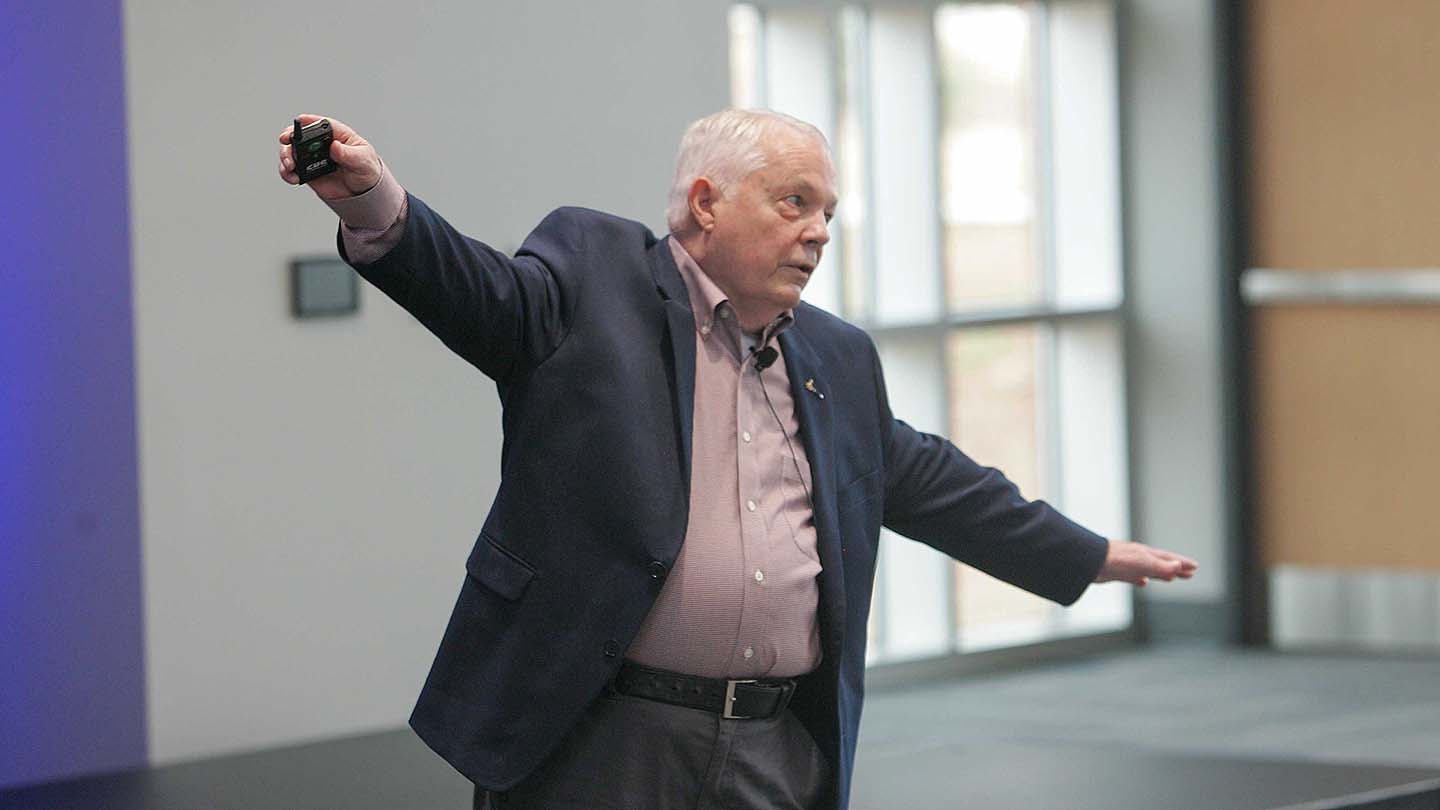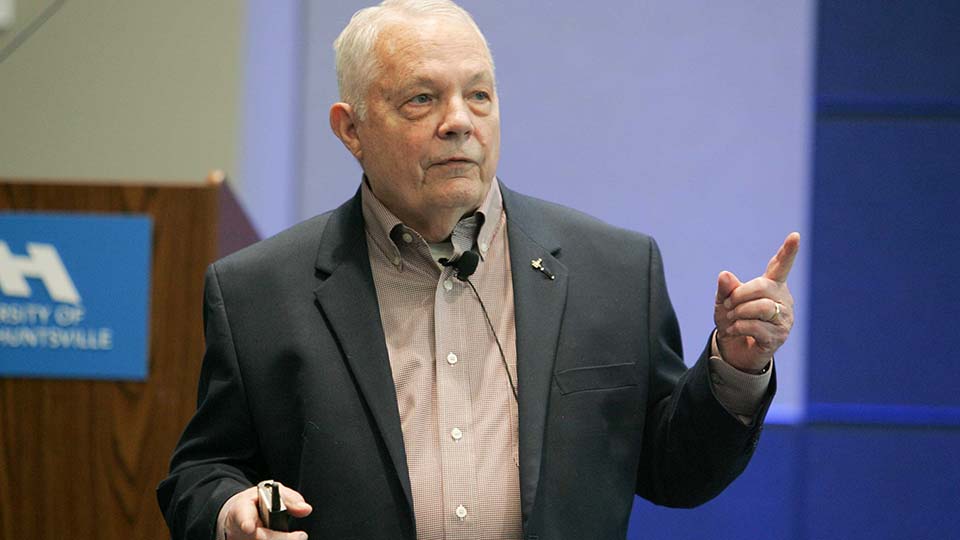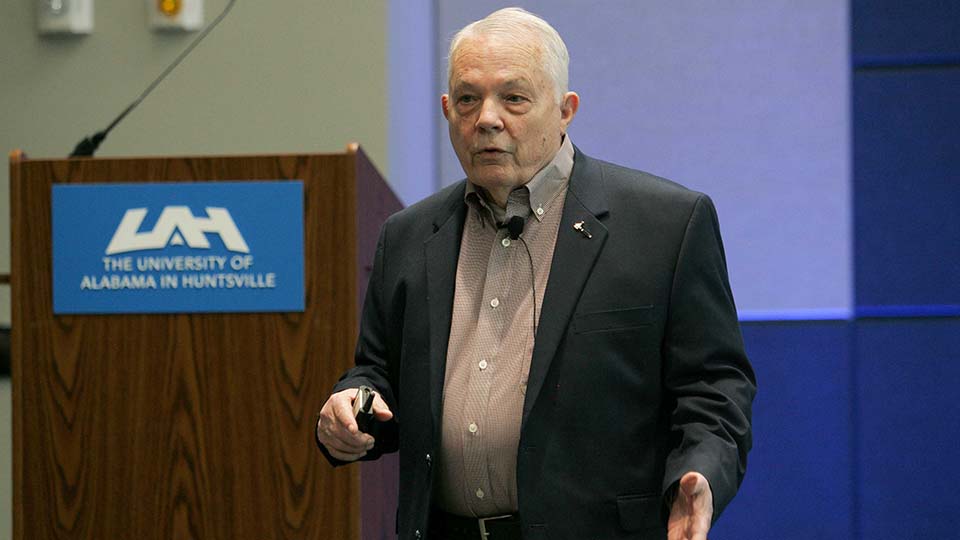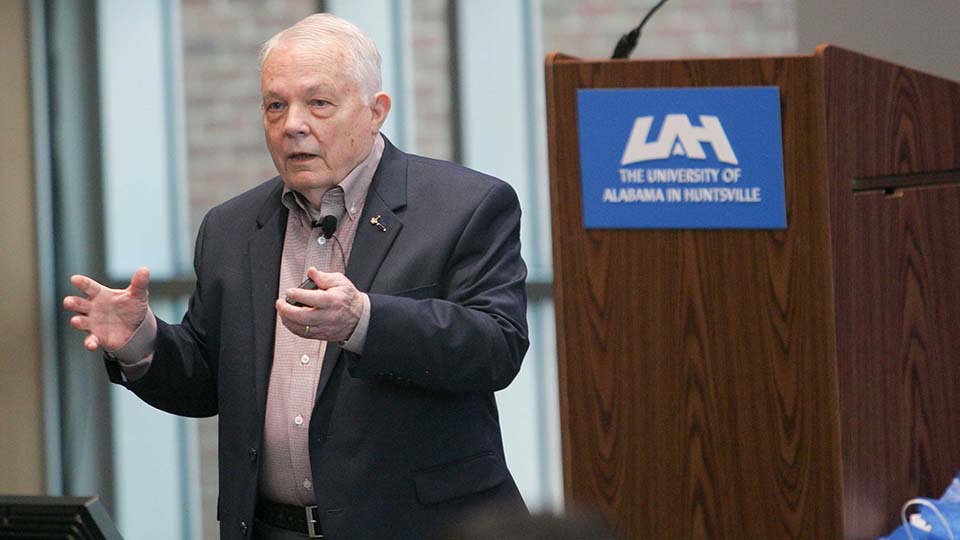
Retired Brigadier General and NASA Astronaut Robert Stewart was College of Engineering Distinguished Speaker. Stewart discussed Aerodynamics and Dynamics of the Helicopter.
Michael Mercier | UAH
The University of Alabama in Huntsville (UAH), a part of the University of Alabama System, featured a lively discussion to kick off its 2022 College of Engineering Distinguished Speaker Series by hosting USA Brigadier General Robert L. Stewart. Gen. Stewart’s topic for the session focused on a special area of expertise for the retired NASA astronaut and longtime pilot, “Aerodynamics and Dynamics of the Helicopter.”
As a highly experienced and decorated Army Aviator and experimental test pilot, Gen. Stewart captivated his audience, not only with an inexhaustible knowledge of his subject, but through wit and sprightly storytelling as well that proved to be a real treat for the capacity crowd on hand in the Student Services Building.
The former astronaut concluded his formal presentation by answering questions from the rapt audience, later enjoying talking with UAH's COE students who are members of the American Institute of Aeronautics and Astronautics (AIAA) Student Chapter advised by MAE Associate Professor, Dr. Gabriel Xu.
Gen. Stewart spent four and a half years as an experimental test pilot where he flew five prototype helicopters, and provided detailed descriptions that broke down rotary winged craft into general classifications: Utility, Armed, Cargo, Observation and Medvac. A particular highlight of his career included serving as the project officer and chief test pilot on the YAH-64 vehicle which ultimately became the Apache armed helicopter.
“This is my baby, the AH-64,” Gen. Stewart said, exhibiting an image of the Apache during the presentation, going on to note the stark impact made by the introduction of rotary winged aircraft into armed conflict. “The helicopter made it possible for us to do things in combat we never could before. If you were in trouble, an airplane could drop you flowers. A helicopter could save your life.”

Michael Mercier / UAH
Gen. Stewart demonstrated that the benefits of helicopters in the field yielded a dramatic impact on troop safety and survival over time, directly borne out by statistics from one war to the next.
“Over 29% of the wounded ground troops in WWII died,” the Brigadier General explained. “In Korea it was 26.3%. By Vietnam we got it down to 19%, due largely to the helicopter.”
The presentation illuminated helicopter design considerations based on mission requirements and detailed the fundamentals of air flow, as well as the rotating components of vertical take-off vehicles and the essentials of lift generation applicable to both fixed and rotary wing aircraft.
“The 0H-6 is strictly a bare bones helicopter, but what a delight to fly,” Gen. Stewart noted. “I could turn that thing so quick, I swear I could see my taillights.”
The veteran pilot went on to point out why he favored certain aircraft over others. “The Tandem Rotor CH-47 Chinook was a cargo helicopter with a very good safety record, but mechanically, very complex,” Gen. Stewart noted. “On one of the very early missions I flew in Vietnam, we went out to recover a crashed Chinook and its crew. When we got there, I saw troops wading calf deep in rice paddy water, and the Chinook was underwater, and I decided then and there to avoid Chinooks if I could. But then at the US Naval Test Pilot School, I flew its older, less sophisticated sibling, the CH-46.
“The Mi-24 carries its own infantry in addition to being a good gunship,” he continued, then discussed how his experiences in training pilots taught him to appreciate craft with less-than-stellar characteristics. “The Hiller OH-23 is my favorite trainer of all time. Because it is a horrible flying helicopter! If a student can fly this, they can fly anything!”
The UH-1 Huey, originally intended for Medvac, eventually evolved to become a gunship and our primary troop transport helicopter, Gen. Stewart recalled. “Its sound will stir the heart of any soldier on the ground – the workhorse of Vietnam.”

Michael Mercier / UAH
The former astronaut received a Bachelor of Science degree in Mathematics from the University of Southern Mississippi in 1964 and a Master of Science degree in Aerospace Engineering from the University of Texas in Arlington in 1972. He has military and civilian experience in some 40 types of airplanes and helicopters, including over 1,200 hours of jet time, 1,015 combat flight hours, and logged over 6,000 hours total flight time.
One of the most fascinating aspects of his talk for the COE series was his ability to clear up longstanding misconceptions, including impressions surrounding a particular category of vehicle widely featured in feature films and TV dramas, so-called “stealth” aircraft like the Boeing RAH-60 Comanche or the Stealthy UH-60 Ghost Hawk.
“Stealth – it doesn’t mean that you can’t see it,” Gen. Stewart said. “It means that you won’t be able to see it until it’s close enough to accomplish its mission.”
His talk also focused on flight controls and the basics of helicopter aerodynamics, as well as clarifying subjects as mystifying to the layman as fully articulated rotors, offset flapping hinges and retreating blade stall. The veteran leavened his more arcane topics with large dollops of humor to keep his listeners transfixed.
“On the teetering rotor, at the top is a big nut that they call the ‘Jesus nut,’ he said. “If it comes off, you’re going to meet Jesus!”
Examples of other topics covered included subjects like flow fields, vortex ring states and antitorque thrust, all vital to helicopter flight and control.

Michael Mercier / UAH
Concerning the subject of “power settling” or Vortex ring state of the rotor, “You don’t like to be out of control in a helicopter,” Gen. Stewart said with a twinkle in his eye. “I hated having to demonstrate this for my students.”
One of the points of emphasis of his discussion was the prime difference between flying an airplane and flying a helicopter.
“I’ve got both hands and both feet busy while flying a helicopter,” the test pilot said. “Any fool can fly an airplane. Flying a helicopter is like a Kabuki dance. I found that I could solo a student just about as fast as in a helicopter as an airplane, but boy are they working harder!”
Gen. Stewart reports that airplane pilots and helicopter pilots can be generally delineated by overall demeanor, as well: airplane pilots tend to be casual and easy-going, while helicopter pilots lean to the more serious, tense or even surly of disposition. The speaker made the difference easy to understand.
“Flying a helicopter or an airplane is a total body experience. But, with a helicopter, even when you are on the ground, you have to be close on the controls, because a helicopter can enter a phase called ‘Ground Resonance,’ which is a fancy way of saying ‘it may try to shake itself apart.’”
One of the most eye-opening points made was in revealing the surprising lack of certainty about just exactly what it is that enables a machine like a helicopter to fly at all.
“We don’t really know how an airfoil, wing or rotor blade produces lift! Your book will say it’s produced by the Bernoulli Effect. That’s not true. It is a real phenomenon elsewhere, but not necessarily on the wings. We’ve known this since 1904. It does not explain things like upwash ahead of the wing or downwash behind the wing or strength of tip vortices. There are three theories in the books, and all three are incomplete.”
Indeed, the pilot asserted that what is known about our understanding of aircraft flight comes down to inexact models and mathematical approximations.

Michael Mercier / UAH
“There is nothing that tells me a complete theory why an aircraft wing can fly,” Gen. Stewart said. “For example, there is no equal transit time over the top and bottom of the wing. Symmetrical airfoils work. How do you explain how an airplane can fly upside down? Wrong is a relative thing. If you say 2 + 2 = 3.5, that’s wrong. If you say 2 + 2 = 3.999999999, it’s also wrong. But it’s a whole lot closer to right than the first one. We engineers are fond of saying our solutions may be wrong, but we will get close enough!”
In fact, mathematical conundrums played an important role in the evolution of the pilot’s career. Gen. Stewart credits an intimidating set of partial differential equations that describe the motion of viscous fluid substances as the impetus leading to a change of course for the pilot.
“I have flown five million miles in space at 17,500 miles per hour, and the Navier-Stokes equations scare me! When I saw this, I decided to become an experimental test pilot.”
As an astronaut, the speaker was a member of the Challenger (1984) and Atlantis (1985) Space Shuttle teams before being promoted to Brigadier General in 1986. He served as Deputy Commanding General, U.S. Army Strategic Defense Command, in Huntsville, and in this capacity managed research efforts in developing ballistic missile defense technology. In 1989 the Brigadier General was reassigned as the Director of Plans, U.S. Space Command, in Colorado Spring, CO. Gen. Stewart retired from the Army in 1992 and currently makes his home in Huntsville.
In concluding his presentation, he managed to make successfully piloting a rotary winged craft resemble nothing so much as negotiating the trickier vagaries of life:
“Everything is conditional in flying a helicopter.”